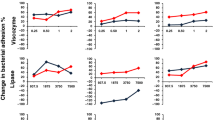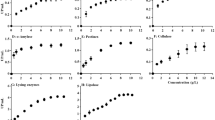Abstract
Enzyme-based antifouling coatings are potential alternative to traditional tributyltin-based coatings in the marine bio-fouling control depended on its environmental friendliness. Proteases are usually the key antifouling active components in enzyme based antifouling coatings. In this work, based on biological antagonism effect, a marine proteolytic bacterial strain of Bacillus velezensis was isolated from the sea mud, and denoted as SM-1. The scanning electron microscope (SEM) revealed that the bacteria are rod-shaped with length 1-1.3 μm. The protease-producing conditions of SM-1 were investigated, and it was found that the culture solution displays higher proteolytic activity under the culture conditions of 35°C, 10‰-20‰ salinity, pH 6–9 and more than 7d culture time. Moreover, the 25kDa protein was confirmed to be the main active component in the crude protease, which was revealed via the experiment of SDS-PAGE. The antifouling assay indicated that the protease SM-1 has remarkable effect on the decomposition of barnacle cement and diatom secretion, and also can effectively inhibit the attachment of barnacle cyprids, diatom and mussel byssus. Therefore, this protease potentially can be used as environmental-friendly antifoulant of enzyme-based marine antifouling coatings, and this work also provides a new approach to obtain antifouling protease via isolating proteolytic bacteria from the sea mud surrounding representative fouling organisms.
Similar content being viewed by others
References
Antizar-Ladislao, B., 2008. Environmental levels, toxicity and human exposure to tributyltin (TBT)-contaminated marine environment. Environment International, 34: 292–308.
Callow, M. E., and Callow, J. A., 2000. Substratum location and zoospore behaviour in the fouling alga Enteromorpha. Bio-fouling, 15(1-3): 49–56.
Cooksey, K. E., and Wigglesworth-Cooksey, B., 1995. Adhesion of bacteria and diatoms to surfaces in the sea: A review. Aquatic Microbial Ecology, 9: 87–96.
Dickinson, G. H., Vega, I. E., Wahl, K. J., Orihuela, B., Beyley, V., Rodriguez, E. N., Everett, R. K., Bonaventura, J., and Rittschof, D., 2009. Barnacle cement: A polymerization model based on evolutionary concepts. Journal of Experimental Biology, 212(21): 3499–3510.
Dobretsov, S., Abed, R. M. M., and Teplitski, M., 2013. Minireview: Inhibition of biofouling by marine microorganisms. Biofouling, 29(4): 423–441, DOI: https://doi.org/10.1080/08927014.2013.776042.
Dobretsov, S., Xiong, H., Ying, X., Levin, L. A., and Qian, P. Y., 2007. Novel antifoulants: Inhibition of larval attachment by proteases. Marine Biotechnology, 9(3): 388–397.
Essock-Burns, T., Wepprich, A., Thompson, A., and Dan, R., 2016. Enzymes manage biofilms on crab surfaces aiding in feeding and antifouling. Journal of Experimental Marine Biology & Ecology, 479: 106–113.
Gebreyohannes, A. Y., Mazzei, R., Poerio, T., Aimar, P., Vankelecom, I., and Giorno, L., 2016. Pectinases immobilization on magnetic nanoparticles and their antifouling performance in a biocatalytic membrane reactor. RSC Advances, 6(101), DOI: https://doi.org/10.1039/C6RA20455D.
Hangler, M., Burmølle, M., Schneider, I., Allermann, K., and Jensen, B., 2009. The serine protease esperase HPF inhibits the formation of multispecies biofilm. Biofouling, 25(7): 667–674.
Harder, T., Lam, C., and Qian, P. Y., 2002. Induction of larval settlement in the polychaete Hydroides elegans by marine biofilms: An investigation of monospecific diatom films as settlement cues. Marine Ecology Progress, 229(1): 105–112.
Huijs, F. M., Klijnstra, J. W., and Van, Z. J., 2006. Antifouling coating comprising a polymer with functional groups bonded to an enzyme. EP 1661955A1.
Kalpana, B. J., Aarthy, S., and Pandian, S. K., 2012. Antibiofilm activity of alpha-amylase from Bacillus subtilis S8-18 against biofilm forming human bacterial pathogens. Applied Biochemistry & Biotechnology, 167(6): 1778–1794.
Kamino, K., 2001. Novel barnacle underwater adhesive protein is a charged amino acid-rich protein constituted by a Cys-rich repetitive sequence. Biochemical Journal, 356 (Pt 2): 503–507.
Khandeparker, L., Gaonkar, C. C., and Desai, D. V., 2013. Degradation of barnacle nauplii: Implications to chitin regulation in the marine environment. Biologia, 68(4): 696–706.
Kristensen, J. B., Olsen, S. M., Laursen, B. S., Kragh, K. M., and Poulsen, C. H., 2010. Enzymatic generation of hydrogen peroxide shows promising antifouling effect. Biofouling, 26(2): 141–153.
Lee, J., Lee, I., Nam, J., Dong, S. H., Yeon, K. M., and Kim, J., 2017. Immobilization and stabilization of acylase on car-boxylated polyaniline nanofibers for highly effective anti-fouling application via quorum quenching. Acs Applied Materials & Interfaces, 9(18): 15424–15432.
Leroy, C., Delbarre, C., Ghillebaert, F., Compere, C., and Combes, D., 2008. Effects of commercial enzymes on the adhesion of a marine biofilm-forming bacterium. Biofouling, 24(1): 11–22.
Mimura, H., 2002. Microbial degradation of mussels removed from the surface of marine structures. Oceans, 1: 338–341.
Nagaraj, V., Skillman, L., Li, D., Xie, Z., and Ho, G., 2017. Control of biofouling by xanthine oxidase on seawater reverse osmosis membranes from a desalination plant: Enzyme production and screening of bacterial isolates from the full-scale plant. Letters in Applied Microbiology, 65(1): 73–81.
Olsen, S. M., Pedersen, L. T., Laursen, M. H., Kiil, S., and Dam-Johansen, K., 2007. Enzyme-based antifouling coatings: A review. Biofouling, 23(5): 369–383.
Scardino, A. J., Harvey, E., and De, N. R., 2006. Testing attachment point theory: Diatom attachment on microtextured polyimide biomimics. Biofouling, 22(1): 55–60.
Shah, K., Mody, K., Keshri, J., and Jha, B., 2010. Purification and characterization of a solvent, detergent and oxidizing agent tolerant protease from Bacillus cereus isolated from the Gulf of Khambhat. Journal of Molecular Catalysis B Enzymatic, 67(1-2): 85–91.
Sikes, C. S., Martin, F., Wierzbicki, A., and Wheeler, A. P., 1997. Atomic force microscopy and enzymatic degradation of oyster shell protein and poly(aspartate). Macromolecular Symposia, 123(1): 85–92.
Sivasubramanian, K., Ravichandran, S., and Vijayapriya, M., 2011. Antagonistic activity of marine bacteria Pseudoaltero-monas tunicata against microbial pathogens. African Journal of Microbiology Research, 5(5): 562–567.
Thune, R. L., Graham, T. E., Riddle, L. M., and Amborski, R. L., 1982. Extracellular protease from Aeromonas hydrophila: Partial purification and effects on age-0 channel catfish. Transactions of the American Fisheries Society, 111(6): 749–754.
Vaterrodt, A., Thallinger, B., Daumann, K., Koch, D., Guebitz, G. M., and Ulbricht, M., 2016. Antifouling and antibacterial multifunctional polyzwitterion/enzyme coating on silicone catheter material prepared by electrostatic layer-by-layer assembly. Langmuir the Acs Journal of Surfaces & Colloids, 32(5): 1347–1359.
Vreeland, V., Waite, J. H., and Epstein, L., 1998. Minireview polyphenols and oxidases in substratum adhesion by marine algae and mussels. Journal of Phycology, 34(1): 1–8.
Wang, H. W., Jiang, Y. J., Zhou, L. Y., and Gao, J., 2015. Bienzyme system immobilized in biomimetic silica for application in antifouling coatings. Chinese Journal of Chemical Engineering, 23(8): 1384–1388.
Wang, L., Lin, C. G., Gao, H. P., Zheng, J. Y., Zhang, J. W., Xu, F. L., and Sui, Y. Q., 2014. Self-organizing preparation and marine fouling bioassays of a honeycomb microstructure surface with controllable dimensions based on silicone-acrylate copolymers. Industrial & Engineering Chemistry Research, 53(45): 17636–17644.
Wezel, A. P. V., and Vlaardingen, P. V., 2004. Environmental risk limits for antifouling substances. Aquatic Toxicology, 66(4): 427–444.
Yebra, D. M., Kill, S., and Dam-Johansen, K., 2004. Antifouling technology-past, present and future steps towards efficient and environmentally friendly antifouling coatings. Progress in Organic Coatings, 50(2): 75–104.
Zanoni, M., Amadio, J., Habimana, O., and Casey, E., 2017. Enzyme-functionalised nanobeads for anti-biofouling purposes. WO 2017046313 A1.
Zanoni, M., Habimana, O., Amadio, J., and Casey, E., 2016. Antifouling activity of enzyme-functionalized silica nano-beads. Biotechnology & Bioengineering, 113(3): 501–512.
Acknowledgments
This work was supported by the National Basic Research Program of China (No. 2014CB643305) and the National Natural Science Foundation of China (No. 213 01161).
Author information
Authors and Affiliations
Corresponding author
Rights and permissions
About this article
Cite this article
Wang, L., Yu, L. & Lin, C. Extraction of Protease Produced by Sea Mud Bacteria and Evaluation of Antifouling Performance. J. Ocean Univ. China 18, 1139–1146 (2019). https://doi.org/10.1007/s11802-019-3843-4
Received:
Revised:
Accepted:
Published:
Issue Date:
DOI: https://doi.org/10.1007/s11802-019-3843-4




